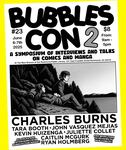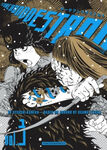
Anyone wanting to pursue a study of comic books can’t do better than to begin with Comic Book Nation. Bradford W. Wright’s book, published in April of 2001 by Johns Hopkins University Press, provides a solid foundation in the history, analysis and criticism of the principal events, trends and personalities as well as of the companies, creators and characters of the first century of comic books in America. The only caveat to this statement is that Wright focuses almost entirely on the mainstream of comic books that has been typically- although certainly not totally-- devoted to the adolescent market. More than simply a history of comic books, however, Comic Book Nation works to articulate and demonstrate the role comic books have played in the rise of the consumer culture that has so altered the American way of life. Specifically, how the marketplace insinuated itself into the transfer of tradition that takes place between each current generation (i.e. that of the parents) and the next (i.e. that of their children). Prior to the introduction of a youth market for consumer goods, of which Wright shows that comic books were arguably in the vanguard, the values of each generation were reproduced through parents, schools, and religious institutions. Comic books managed to get right in between the generations (perhaps initiating what came to be known as the “generation gap”) and present values and versions of reality-- however distorted-- directly to the youth of the 1930’s, ‘40’s and ‘50’s, and, although to an ever decreasing extent, to the youth of the 1960's to the present as well. Wright intimates that the commodification of youth culture began with the comic book. It was the recognition of this, however ill-formed and misapprehended, that precipitated the anti-comic hysteria that gripped the nation in the early 1950’s. The anti-comic crusade led by Dr. Fredric Wertham ended comics' dominance of the youth and young adult entertainment market, but in no way had any lasting effect on the rise of a consumer culture in which values are transmitted-- to all, but especially to the young and impressionable-- through commodities marketed by corporations. Thus, while the youth of today-- as well as, it is important to note, more and more of the adults of today who were, of course, the children of yesterday-- are presented with a myriad of choices in the marketplace out of which to forge their identities-- from television programming (the primary form of which is the commercial), movies, music, video games, books and magazines produced and delivered to them by the established entertainment conglomerates to all the offerings of the internet and world wide web which are, of course, being rapidly colonized by these same established interests-- few today realize or even consider that it was the comic book that pioneered this transformation of American culture that lies at the roots of the “Culture Wars” that currently divide this country (and seem likely to divide the rest of the world as well), in the process rendering obsolete the old political divisions of Left and Right. More than any political policy, it is the struggle over who exactly is in charge of transmitting tradition from one generation to the next, and by extension who gets to decide what constitutes that tradition that is what defines and divides “liberal” and “conservative". Regardless of which side of the debate you find yourself on it is hard to argue against the statement that it is exactly this ability-- some might say necessity-- to forge one’s own identity in the marketplace and away from the traditional bearers and transmitters -- some might say imposers-- of value (i.e. the institutions of family, education and religion) that distinguishes American culture from all others that have come before it, responsible for both the adulation and the vituperation that American culture is greeted with around the world. Time and again, when American culture begins to make inroads into a foreign land it is feared and denigrated by the old (i.e. the present generation, the bearers of tradition) while it is embraced by the young (i.e. the next generation, the intended recipients of that tradition). It is not difficult to understand why. Comic Book Nation charts the rise and decline of the comic book industry with a deft hand and observant style that is markedly free of cant and stridency. Wright’s ability to meld a critical understanding of the history and practices of the companies that produced and distributed comic books with an incisive cultural interpretation of the meaning and significance of their contents is admirable and one can only hope that it will be seen by others working in the field as an example worthy of expanding on. This is a book that will increase the appreciation and understanding of the place of comic books in American culture for anyone-- whether a life long aficionado of comics or a novice initiate-- who reads it. And should anyone be considering teaching a class either entirely on comic books or incorporating a unit on comic books within a course on American popular culture, that person need look no further than Comic Book Nation to have an ideal core text in hand.
NOW OUT OF PRINT> We still have a copy or two...










